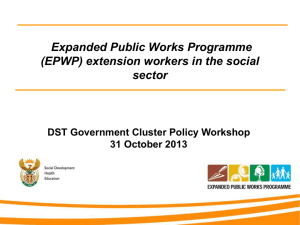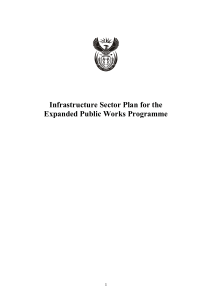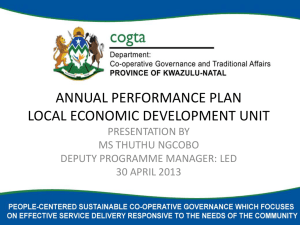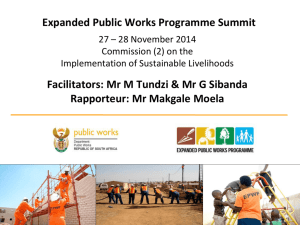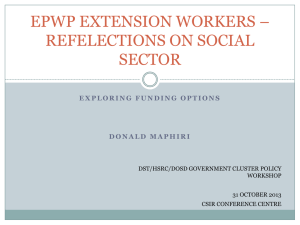DEPARTMENT OF PUBLIC WORKS
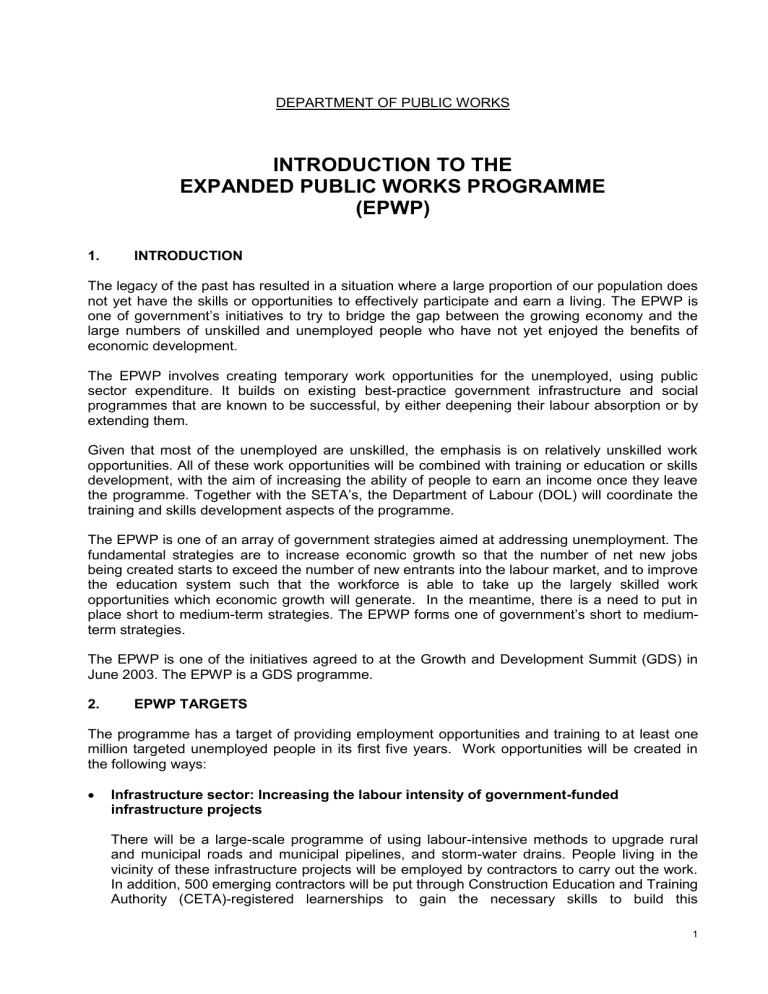
DEPARTMENT OF PUBLIC WORKS
INTRODUCTION TO THE
EXPANDED PUBLIC WORKS PROGRAMME
(EPWP)
1. INTRODUCTION
The legacy of the past has resulted in a situation where a large proportion of our population does not yet have the skills or opportunities to effectively participate and earn a living. The EPWP is one of government’s initiatives to try to bridge the gap between the growing economy and the large numbers of unskilled and unemployed people who have not yet enjoyed the benefits of economic development.
The EPWP involves creating temporary work opportunities for the unemployed, using public sector expenditure. It builds on existing best-practice government infrastructure and social programmes that are known to be successful, by either deepening their labour absorption or by extending them.
Given that most of the unemployed are unskilled, the emphasis is on relatively unskilled work opportunities. All of these work opportunities will be combined with training or education or skills development, with the aim of increasing the ability of people to earn an income once they leave the programme. Together with the SETA’s, the Department of Labour (DOL) will coordinate the training and skills development aspects of the programme.
The EPWP is one of an array of government strategies aimed at addressing unemployment. The fundamental strategies are to increase economic growth so that the number of net new jobs being created starts to exceed the number of new entrants into the labour market, and to improve the education system such that the workforce is able to take up the largely skilled work opportunities which economic growth will generate. In the meantime, there is a need to put in place short to mediumterm strategies. The EPWP forms one of government’s short to mediumterm strategies.
The EPWP is one of the initiatives agreed to at the Growth and Development Summit (GDS) in
June 2003. The EPWP is a GDS programme.
2. EPWP TARGETS
The programme has a target of providing employment opportunities and training to at least one million targeted unemployed people in its first five years. Work opportunities will be created in the following ways:
Infrastructure sector: Increasing the labour intensity of government-funded infrastructure projects
There will be a large-scale programme of using labour-intensive methods to upgrade rural and municipal roads and municipal pipelines, and storm-water drains. People living in the vicinity of these infrastructure projects will be employed by contractors to carry out the work.
In addition, 500 emerging contractors will be put through Construction Education and Training
Authority (CETA)-registered learnerships to gain the necessary skills to build this
1
infrastructure labour-intensively. DPW will also arrange for access to finance for these learner contractors.
Labour-intensive construction methods involve the use of an appropriate mix of labour and machines, with a preference for labour where technically and economically feasible, without compromising the quality of the product. International and local experience has shown that, with well trained supervisory staff and an appropriate employment framework, labourintensive methods can be used successfully for certain types of infrastructure projects.
Labour-intensive infrastructure projects under the EPWP involve:
using labour intensive construction methods to provide employment opportunities to local unemployed people;
providing training or skills development to those locally employed workers;
building cost-effective and quality assets.
Environmental sector: Creating work opportunities in public environmental programmes (e.g. Working for Water)
The environmental sector will involve employment of people to work on projects to improve their local environments, under programmes such as the Department of Agriculture’s Land
Care programme; the Department of Environmental Affairs and Tourism’s People and Parks,
Coastal Care, Sustainable Land-based Livelihoods, Cleaning up SA, Growing a Tourism
Economy programmes; and the Department of Wa ter Affairs and Forestry’s Working for
Water, Wetlands, and Fire programmes. A target of 200 000 employment opportunities over the next five years has been set for this sector.
Social sector: Creating work opportunities in public social programmes (e.g. community-based health and social welfare care and early childhood development)
The social sector will involve the employment of people by NGOs and CBOs, to work on home-based care programmes and early childhood development programmes. These programmes will be coordinated by Departments of Social Development, Health and
Education.
Economic sector: Developing small businesses and cooperatives, including utilising general government expenditure on goods and services to provide the work experience component of small enterprise learnership / incubation programmes .
The social and economic sectors will be formulating targets shortly.
3.
The conditions of employment of workers on EPWP projects will be governed by the Code of
Good Practice for Special Public Works Programmes. This Code was gazetted by the
Department of Labour after discussions at NEDLAC.
FUNDING
Funds for EPWP programmes will be allocated to national departments, provinces and municipalities through the normal budgeting process. The Department of Public Works does not have a fund for funding EPWP projects.
The table below indicates the funds which will be allocated to the EPWP programmes described above over the next five years:
2
SECTOR
Infrastructure
Environmental and cultural
Social
Economic
ALLOCATIONS TO EPWP
PROGRAMMESS 2004/5 – 2008/9
R15 billion
R 4 billion
At least R 600 million
Still to be determined
4. INSTITUTIONAL ARRANGEMENTS
The EPWP is a programme which cuts across all government departments and all spheres of government. Under the EPWP, all government bodies and parastatals are required to make a systematic effort to target the unskilled unemployed. They will do this by formulating plans for utilising their budgets to draw significant numbers of the unemployed into productive work, in such a way that workers gain skills while they work, to increase their chances of getting out of the marginalised pool of unemployed people.
The Department of Public Works will be responsible for overall coordination of the programme.
The Department of Public Works will also formulate and coordinate EPWP programmes in the infrastructure sector, building on existing initiatives such as the Zibambele road maintenance programme in KwaZulu Natal, the Gundo Lashu road construction programme in Limpopo, the
Zivuseni building maintenance in programme in Gauteng, and the labour-intensive construction of water pipelines under the Department of Water Affairs’ Community Water Supply and
Sanitation programme. The Department of Environmental Affairs and Tourism will be responsible for coordinating implementation of the EPWP in the environment sector, through programmes such as the Working for Water programmes, the Land Care programme, the
Coastal Care programme, and the Waste Management programme. The Department of Trade and Industry will be responsible for coordinating the EPWP in the economic sector, including programmes such as incubator programmes for small businesses which obtain work from government and community-based income-generating projects.
In the Social Cluster, the Department of Social Development will be responsible for formulating and coordinating EPWP programmes in the areas of social and personal services (such as home-based care for people living with HIV/AIDS and early childhood development) and food and nutrition.
The national sector coordinating departments will be required to provide regular reports to
Cabinet regarding progress with the implementation of the EPWP in each sector.
As the main delivery arms of government, provinces and municipalities will be the primary project implementing bodies for the EPWP. They will be supported by the national government departments responsible for sectoral coordination.
3
Linkage with other programmes
Funding
FREQUENTLY ASKED QUESTIONS ON THE EPWP
What will be the effect of the EPWP on other existing labour intensive projects currently running?
Existing programmes and projects that are labour intensive and aimed at creating employment opportunities will from the 1 st April 2004 be phased under the EPWP umbrella.
How does the Community Based Public Works Programme (CBPWP) link to EPWP and how different is the EPWP from the CBPWP?
The CBPWP will be phased out by the Department. In order to achieve integrated planning that makes maximum use of the Integrated Development
Plans, the Department through consultation with stakeholders decided not to keep a separate fund such as the CBPWP at national level but rather let municipalities who are at ground level implement and maintain local infrastructure. Funds that would have been allocated to the CBPWP will form part of the Conditional Municipal Infrastructure Grants (MIG) from which the municipalities will fund infrastructure EPWP projects.
How will the EPWP be funded. Do municipalities have to put in Business
Plans to the Department to access funding?
The EPWP infrastructure projects will be funded through the Municipal
Infrastructure Grant that the municipalities will be allocated by Treasury through
DPLG. Municipalities will identify infrastructure projects through the IDP process and use that to identify projects that are amenable for labour intensive methods. There are no Business plans to be submitted to the National
Department of Public Works as funds come directly to municipalities. The MIG will have conditionalities attached that activities such as low volume roads, trenching, stormwater drains, side walks should be done using labour intensive methods.
Funding for the Environmental and Cultural Sector programmes and from the
Social Sector will come through the line Departments and through special poverty relief fund that has already been approved.
How much is budgeted for the EPWP infrastructure projects
45bn has been allocated to the conditional municipal infrastructure grant over the next 5 years, 15bn of this will be spent on labour intensive construction methods over the next 5 years. These are projects that are human centred and aim to create more jobs and alleviate poverty and reduce unemployment. Some of the special poverty relief allocation fund, the CBPWP and CMIP funds will be consolidated into the PIG and MIG grants as these special funds are phased out.
What is the MIG allocation for my municipality. Will it come through
District municipalities or as a local municipality we get allocations directly?
Molatelo to give input
4
Institutional
Arrangements
How will the EPWP be implemented?
Under the EPWP, all government departments, provinces, municipalities and parastatals involved in infrastructure provision will be required to take steps to increase the employment creation resulting from their infrastructure programmes, where technically and economically feasible.
Although government will take this approach with all of its infrastructure projects, there will be a particular focus on relatively simple infrastructure which is particularly amenable to the introduction of labour-intensive methods, and where the most additional work opportunities can be created, i.e. rural roads, local municipal roads, water and sewer pipelines and stormwater drainage. There are huge backlogs of these types of infrastructure in historically disadvantaged rural areas and municipalities.
These backlogs also tend to be in areas where unemployment is particularly high. Using prioritisation processes and the IDPs, provinces and municipalities should identify those projects that could absorb a lot of local labour and design them using labour intensive methods. Framework Guidelines for the design of labour intensive infrastructure have been distributed to municipalities and other industry stakeholders and is available from DPW. The
DPW stands to assist when required.
Over the next five years, government will be increasing its budgetary allocations to make substantial inroads into these backlogs, through increasing Municipal Infrastructure Grant allocations to municipalities, and through increasing Provincial Infrastructure Grant allocations to provinces. Additional conditionalities will be attached to these conditional infrastructure grants, requiring provinces and municipalities to carry out these projects labour intensively.
Environmental and Cultural Sector and Social Sector projects will be implemented through current line departmental arrangements. The possibility of using other implementing models is being investigated.
How will the programme be managed and monitored
Management at project level rests with the employer and owner of the asset, i.e. a municipality of province. The municipality and/or province will be responsible for the correct implementation of projects and would account to the Auditor
General for funds dispersed. Municipalities and Provinces would be required to report on EPWP key indicators to DPW through monitoring systems put in place by DPW and DPLG based on other requirements from treasury. DPW will also put in place provincial project managers who will coordinate EPWP provincially.
All provinces will be having a provincial structure that will manage and monitor the implementation of the EPWP provincially.
Is there sufficient capacity to properly implement and manage labour intensive construction projects?
5
Training
Rate of Pay
The DPW recognizes that there might be insufficient labour intensive expertise.
In order for the labour-intensive infrastructure programmes to be implemented, contractors will need to be trained in the use of labourintensive construction methods. To this end, the Department of Public
Works and the Construction Education and Training Authority (CETA) will be selecting 750 emerging contractors countrywide to go onto learnerships to become qualified to build and maintain these types of infrastructure using labour-intensive construction methods.
Government’s increasing expenditure on labour-intensive infrastructure programmes will sustain these contractors in the long-term.
The Department of Public Works has put in place guidelines for appropriate designs and tender documentation for labour intensive infrastructure programmes.
These Guidelines give guidance on contract documentation and design checklist activities suitable for labour intensive methods. Municipalities are to select sections of the Guidelines and insert them in the tender documentation for Labour intensive projects.
Together with the Construction Education and Training Authority (CETA), the Department is also coordinating the process of building the capacity of the construction industry for labour-intensive construction. Work is underway to put in place the required SAQA-approved unit standards, qualifications, assessment instruments and training materials, and to ensure that training providers have the necessary capacity to provide the required training programmes for the supervisory and managerial staff of contracting and engineering firms.
In order to develop the capacity of the construction industry to manage labour-intensive projects, the additional conditionalities mentioned above will also include an eligibility requirement for the appointment of contractors and consulting engineers, i.e. that their key staff involved in the project must undergo special NQF-accredited training programmes in labour-intensive construction.
Who qualifies for the Contractor Learnership Programme?
This is an open and transparent process. Emerging civil contractors and individuals who are starting up in the construction industry can apply to the DPW through their municipalities who must indicate to the DPW that they have enough in their capital budget to provide three projects for the trainee contractor to do practical training. The CETA will sponsor 750 learnerships initially and applications are reviewed as they come. The Learnerships are based on framework for NQF level 2 to NQF level 4.
What is this 10 day training course and who pays for training?
For the Infrastructure Sector, t he workers employed on the EPWP projects will all be provided with training in terms of the Code of Good Practice for
Special Public Works Programmes. This training will be aimed at equipping the participants with skills which will enhance their ability to obtain an income after the projects have been completed. The
Department of Labour will fund these training programmes and assist with their implementation.
What is the EPWP rate of pay under these special conditions?
6
Because the EPWP cross cuts between sectors and departments, there is no set EPWP rate. For the Infrastructure sector, there is no one set rate of pay.
Municipalities and provinces must be guided by the prevailing minimum wage in the area and ongoing poverty relief projects. The aim is not to displace workers from existing employment to new EPWP projects. Allowance is made for EPWP projects to pay below minimum wage as Gazetted in the Code of Good practice for employment under the Special Public Works Programme.
7
